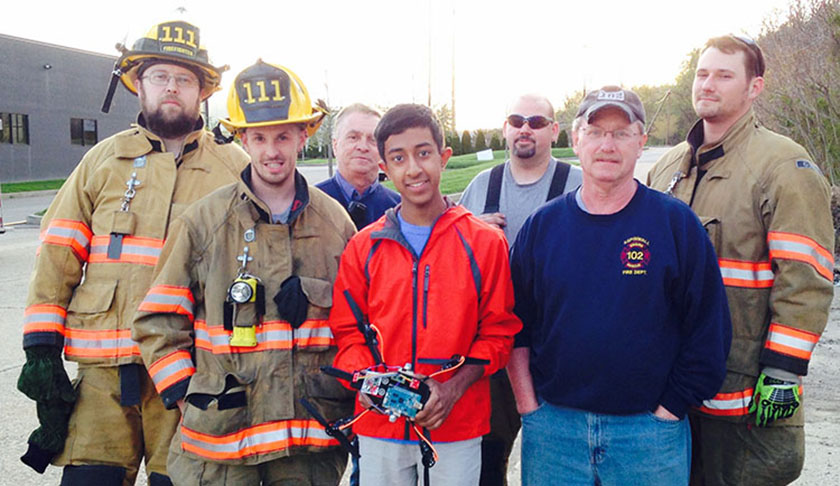‘Science greats show me importance of sharing science fair work with the world’

By Mihir Garimella
Senior, Fox Chapel Area High School, Pittsburgh, Pa.
Broadcom MASTERS 2013 finalist, Intel ISEF 2015 finalist
President Barack Obama coming to town is a pretty big deal, and having the chance to actually meet him in person is even cooler. A few weeks ago, I had the incredible opportunity to do just this at the White House Frontiers Conference, hosted in my home city of Pittsburgh. When I found out that the Society for Science & the Public had gotten me an invitation to the conference, I was ecstatic — and the event ended up exceeding my wildest expectations.
I attended the conference’s Local Frontiers track, which focused on using technology on the scale of individual communities to improve daily life. One major portion of the session focused on designing the transportation networks of the future. I was really impressed with how the panelists collaboratively brainstormed a vision for a next-generation transportation network on stage, right in front of us.
The conference showed me how important it is to take this extra step of bringing your work out into the world — to real people and communities who could benefit.
Robin Chase, who co-founded Zipcar, talked about how tremendous amounts of time and space are wasted on parking when the average car is only in use for around 4 percent of the time. This helped motivate Zipcar’s car-sharing model. Tim Kentley-Klay, who runs a self-driving car startup called Zoox, described how self-driving cars might work, navigating autonomously and talking with other cars to completely take over driving from humans. Together with a few others, they built up a vision of a network of shared self-driving taxis that you could request from within an app on-demand, and quantified the impact this might have.
The panel reminded me of the engineering method; it seemed like none of the speakers had the entire answer at the beginning of the session, but worked from goals, ideas, and previous approaches to develop and iterate a solution on stage.
After the individual track sessions, all of the conference attendees gathered in a large auditorium for the second portion of the event. We heard from a variety of speakers in different fields, from space exploration to social entrepreneurship.
One session that I really enjoyed: a live podcast produced on stage by Roman Mars, who runs a popular podcast called 99% Invisible. The podcast featured Stanford economist Raj Chetty, who discussed social mobility and income equality in America. The podcast was interesting and very well-done; the idea to package a conference talk — complete with graphs projected on a screen — in the concise, conversational format of a podcast was a really clever way to keep the audience interested.
President Obama spoke about the future of healthcare, initiatives to reverse engineer the human brain, and bringing personalized medicine to the masses.
After these speakers, we heard from none other than President Obama, who spoke for quite a while about how important science and technology policy is to shaping the future of our country. He also spoke on a panel about the future of healthcare — describing initiatives to reverse engineer the human brain (which is personally fascinating to me, since my high school research has revolved around creating bio-inspired robots) and bringing personalized medicine to the masses.
I was impressed by his ability to discuss topics that he didn’t have a formal background in with such precision and thoughtfulness. He used the proper terminology — he’d frequently say things like “microelectrode array” — which appealed to my inner nerd. Then, he came down in front of the audience and I got to shake his hand! All in all, an incredible experience.
Besides the formal conference sessions, I had an opportunity to meet a number of amazing people, from the CEOs of Fitbit and Virgin Galactic to the Director of the National Science Foundation, who all asked about my science fair projects.
I was impressed by [President Obama’s] ability to discuss topics that he didn’t have a formal background in … [it] appealed to my inner nerd.
I also had the chance to meet Yann LeCun, one of the inventors of deep learning (a machine learning technique that has been used to demonstrate remarkable recent results in image recognition and other tasks) and an absolute legend. Later, as a few Society for Science & the Public alumni and I were walking to Starbucks after the conference, and Dr. John Holdren, President Obama’s Chief Scientific Adviser, recognized us and waved!
In all, the Frontiers Conference was a once-in-a-lifetime experience. Too often in science (and especially in high school science research), we talk about the impact our work could have but don’t actually get our research out there, into the field. Throughout both the Local track and the afternoon sessions, the conference showed me how important it is to take this extra step of bringing your work out into the world — to real people and communities who could benefit.


